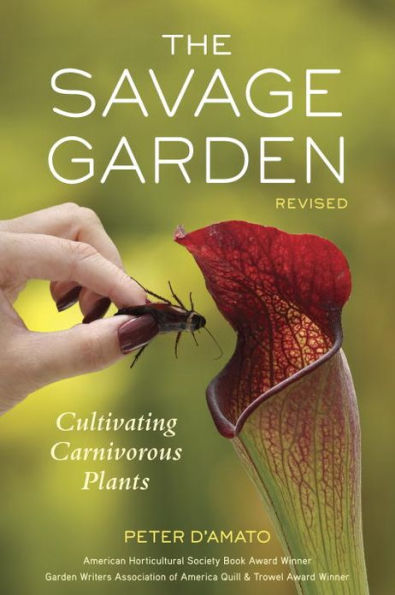For fifteen years, The Savage Garden has been the number one bestselling bible for those interested in growing carnivorous plants. This new edition is fully revised to include the latest developments and discoveries in the carnivorous plant world, making it the most accurate and up to date book of its kind.
You may be familiar with the Venus flytrap, but did you know that some pitcher plants can—and do—digest an entire rat? Or that there are several hundred
species of carnivorous plants on our planet? Beautiful, unusual, and surprisingly easy to grow, flesh-eating plants thrive everywhere from windowsills to outdoor container gardens, in a wide variety of climates. The Savage Garden is the most comprehensive guide to these fascinating oddities, gloriously illustrated with more than 200 color photos. Fully revised with the latest developments in the carnivorous plant world, this new edition includes:
• All the basics—from watering and feeding to modern advances in artificial lighting, soil, and fertilizers.
• Detailed descriptions of hundreds of plants, including many of the incredible new species that have been recently discovered and hybridized.
• Cultivation and propagation information for all the plant families: pitcher plants, Venus flytraps, sundews, rainbow plants, bladderworts, and many other peculiar plants from the demented mind of Mother Nature.
Whether you’re a beginner with your first flytrap or an expert looking for the latest exotic specimen, this classic book has everything you need to grow your very own little garden of horrors.
For fifteen years, The Savage Garden has been the number one bestselling bible for those interested in growing carnivorous plants. This new edition is fully revised to include the latest developments and discoveries in the carnivorous plant world, making it the most accurate and up to date book of its kind.
You may be familiar with the Venus flytrap, but did you know that some pitcher plants can—and do—digest an entire rat? Or that there are several hundred
species of carnivorous plants on our planet? Beautiful, unusual, and surprisingly easy to grow, flesh-eating plants thrive everywhere from windowsills to outdoor container gardens, in a wide variety of climates. The Savage Garden is the most comprehensive guide to these fascinating oddities, gloriously illustrated with more than 200 color photos. Fully revised with the latest developments in the carnivorous plant world, this new edition includes:
• All the basics—from watering and feeding to modern advances in artificial lighting, soil, and fertilizers.
• Detailed descriptions of hundreds of plants, including many of the incredible new species that have been recently discovered and hybridized.
• Cultivation and propagation information for all the plant families: pitcher plants, Venus flytraps, sundews, rainbow plants, bladderworts, and many other peculiar plants from the demented mind of Mother Nature.
Whether you’re a beginner with your first flytrap or an expert looking for the latest exotic specimen, this classic book has everything you need to grow your very own little garden of horrors.

The Savage Garden, Revised: Cultivating Carnivorous Plants
384
The Savage Garden, Revised: Cultivating Carnivorous Plants
384Paperback(Revised)
Related collections and offers

Product Details
| ISBN-13: | 9781607744108 |
|---|---|
| Publisher: | Ten Speed Press |
| Publication date: | 07/02/2013 |
| Edition description: | Revised |
| Pages: | 384 |
| Sales rank: | 57,812 |
| Product dimensions: | 5.50(w) x 9.42(h) x 1.00(d) |
About the Author
Customer Reviews
Explore More Items
The New Year is right around the corner, and there's a big question on all the girls' minds: Where should each of them go to see the first sunrise of the year's Whether it's by the ocean or in
“[The Rise of Wolf 8] is a goldmine for information on all aspects
Beetles of Eastern North America is a landmark book—the most comprehensive full-color guide to the remarkably
Christmas has come to Tinker’s Cove, Maine, and sleuthing skills are at the top of Lucy’s Stone’s wish list in these two beloved mysteries—now collected in one festive volume
If you dream of living in a tiny house, or creating a getaway in the backwoods or your backyard, you’ll love this gorgeous collection of creative and inspiring designs for cabins, forts,
Dress codes are as old as
Succulents are hot. And Debra Lee Baldwin, the bestselling author of Designing with Succulents and Succulent Container Gardens, is the ideal guide for gardeners, crafters, and DIYers looking for an
This award-winning book addresses the needs of people who want to take control of the food they eat and the products they use—even if they live in an urban or suburban house on a typical-size
Small garden, tiny garden, or no garden at all? Small Space Garden Ideas is perfect for people who have very little room for gardening, whether a doorstep, balcony, or part of a wall. Get inspired to
“Absolutely the best book in the world on how to grow diverse and delicious
Breaks down key information on cultivating bonsai into 101 easy-to-grasp tips and gives quick answers to all your questions.
